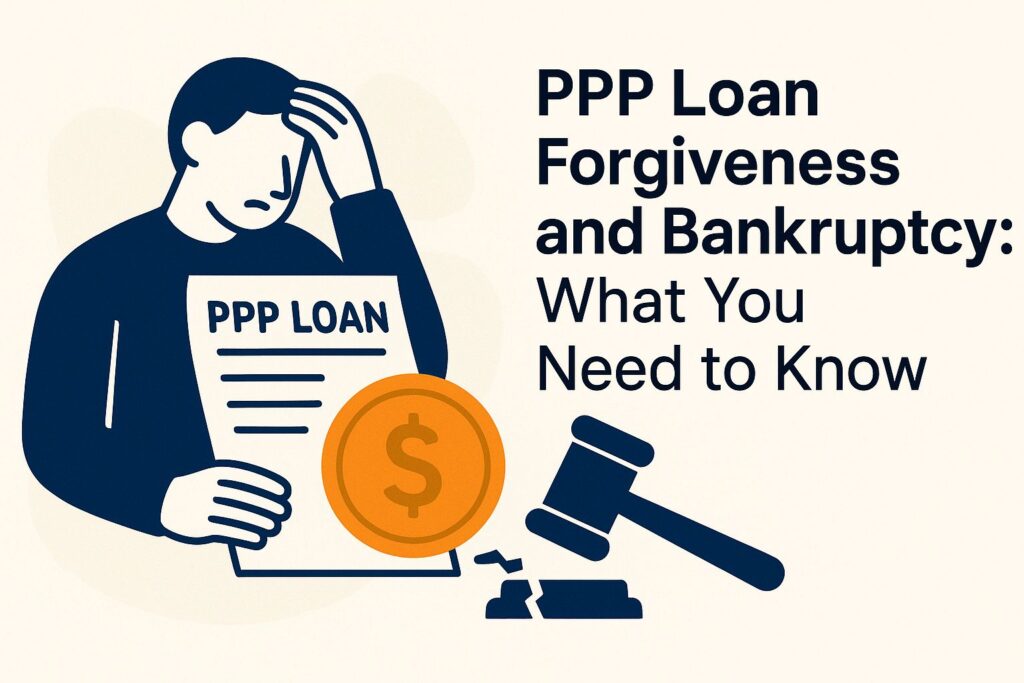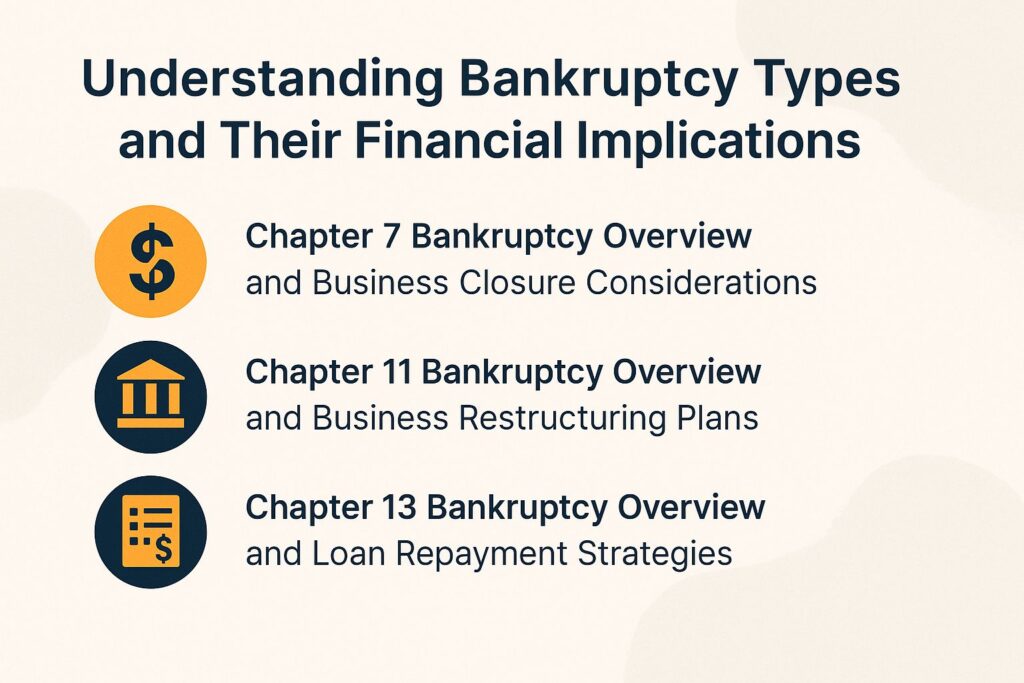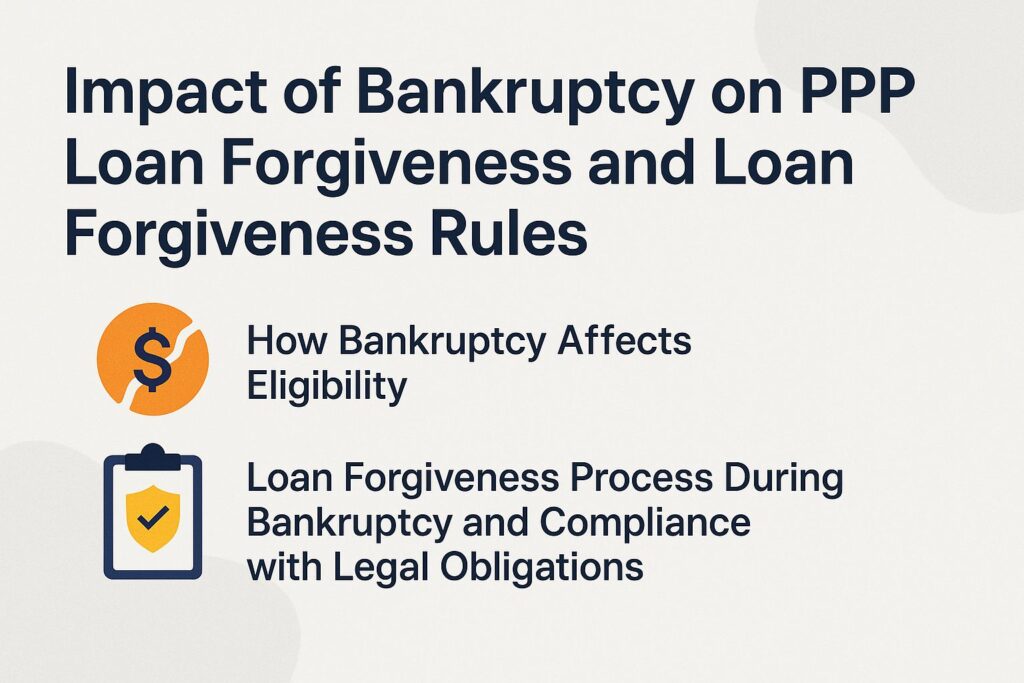
PPP Loan Forgiveness and Bankruptcy: What You Need to Know
Figuring out how to get PPP loans forgiven can be tough, especially when you’re dealing with money problems and possible bankruptcy. Knowing how these two financial options connect is key for business owners looking for debt relief and better cash flow. This guide by PEOcosts.com will explain the PPP loan process, describe who can apply for loan forgiveness, and look at how different bankruptcy types affect your chances of getting relief. Look at important strategies and challenges, ensuring you have the details required to manage these legal duties effectively.
What is the PPP Loan and Federal Aid Program?
The PPP is a federal loan program launched by the Small Business Administration (SBA) designed to help businesses retain employees during the economic downturn caused by COVID-19, thereby maintaining business continuity.
Introduced in March 2020 as part of the CARES Act, the Paycheck Protection Program aimed to provide financial relief to small businesses facing closures, revenue losses, and insolvency challenges.
By offering forgivable loans, businesses could cover essential expenses like payroll, rent, utilities, and interest rates on existing business debt. Eligible businesses could apply for loans up to $10 million, depending on their average monthly payroll.
To maximize benefits, businesses needed to use at least 60% of the loan for payroll within 24 weeks, ensuring the preservation of jobs and workforce retention. This approach aligns with the principles outlined in our analysis of how a PEO protects businesses from potential financial risks.
Purpose of the PPP Loan and Economic Stimulus
The main purpose of the PPP loan is to provide businesses with funds specifically for payroll costs, to avoid layoffs and maintain workforce stability during financial downturns.
Along with payroll, PPP funds can also be used for rent, utilities, and mortgage interest, ensuring that businesses can sustain their operations.
For example, a restaurant could allocate part of its loan to cover employee wages while utilizing some funds for monthly rent.
To fully benefit from these loans, businesses need to keep detailed financial documentation of their expenses. Accurate documentation is needed to qualify for full loan forgiveness.
By effectively using these funds, companies can keep jobs, maintain business viability, and help with the overall economic recovery.
Overview of Loan Forgiveness Process and Eligibility Assessment
The loan forgiveness process involves submitting an application to the SBA along with documentation of eligible expenses incurred during the covered period, ensuring compliance with program guidelines.
- To maximize your chances of approval, carefully gather all required documentation, including payroll records, utility bills, and rent statements.
- Check that your total qualified expenses are the same as the amounts you are asking to be forgiven. Keep detailed records of how money was spent – this openness is important.
- It’s also important to verify that you’ve maintained your employee headcount during the covered period, as this influences eligibility.
- Think about using SBA resources or talking to a financial advisor to help you with the application process.
Eligibility for PPP Loan Forgiveness and Funding Options

Knowing who qualifies for PPP loan forgiveness is important for business owners to get the most out of their loan and prevent unwanted financial issues.
Who Qualifies for Forgiveness?
Businesses must meet specific criteria, including maintaining employee headcount and ensuring funds are used for allowable expenses, to qualify for forgiveness of their PPP loans.
To effectively qualify, organizations should track their employee numbers, ensuring they do not drop below the pre-pandemic levels established in the loan application. They must confirm that at least 60% of the funds were used for payroll expenses, as this is a key requirement for forgiveness.
Tracking expenses accurately is possible with accounting practices and software such as QuickBooks or Wave. Regularly reviewing these metrics can also prevent any miscalculations that could jeopardize forgiveness status.
Eligible Expenses for Forgiveness and Compliance Requirements
Expenses that can be forgiven mainly cover payroll, mortgage interest, rent, and utilities, giving businesses a clear plan for using PPP money well.
To qualify, at least 60% of the forgiven amount must be attributed to payroll expenses, ensuring that employee salaries and workforce retention are prioritized.
Up to 40% can cover non-payroll costs, including mortgage interest, rent, and utilities like electricity and water.
For example, if a business receives $100,000 in PPP funds, at least $60,000 must be allocated to payroll. This structure incentivizes businesses to retain employees while managing their essential operational overhead.
Documentation Requirements and Loan Audit Necessities
To successfully have a loan forgiven, businesses need to collect all necessary paperwork, such as payroll records, tax documents, and receipts for eligible expenses.
- Start by organizing your payroll records to show employee counts and wages paid during the covered period. Keep your tax records correct to confirm your business’s financial situation, including IRS Form 941.
- Collect receipts for qualifying expenses such as rent, utilities, and mortgage interest. Using tools like QuickBooks or Expensify can make this organization process easier.
- Make sure all paperwork meets the rules from the Small Business Administration (SBA) to prevent any hold-ups in your application. Keeping accurate records can help you qualify for forgiveness.
Different Kinds of Bankruptcy and What They Mean for Finances

Knowing how different bankruptcy types affect a business can change how it manages PPP loans.
Chapter 7 Bankruptcy Overview and Business Closure Considerations
Chapter 7 Bankruptcy lets businesses sell their assets to pay back creditors. This can result in debts being cleared, but it may also impact their ability to get loans later.
The liquidation process involves selling off assets to generate funds for creditors, with a trustee overseeing the distribution.
Business owners may face implications such as loss of control over their company’s assets and the possibility of personal liability if they provided personal guarantees on loans.
Loans received through the Paycheck Protection Program (PPP) could be affected; while PPP loans are usually forgivable, Chapter 7 may complicate this process, often rendering specific loans non-repayable.
It is important to talk to a financial advisor for legal advice and strategic planning before moving forward.
Chapter 11 Bankruptcy Overview and Business Restructuring Plans
Chapter 11 Bankruptcy allows businesses to reorganize their debts and keep running, which can impact their ability to handle PPP loans and request forgiveness.
During the restructuring process, a business can negotiate with creditors to modify repayment terms or reduce the amount owed.
For instance, if a company has secured a PPP loan, it can strategically prioritize debt repayment based on its financial projections post-restructuring.
Utilizing financial management tools like QuickBooks or Xero helps track funds and expenses related to the PPP loan, ensuring compliance with forgiveness requirements.
This proactive approach helps meet obligations and makes the business stronger in upcoming negotiations.
Chapter 13 Bankruptcy Overview and Loan Repayment Strategies
Chapter 13 bankruptcy allows individuals and small businesses to create a repayment plan to settle debts over time, presenting unique challenges and opportunities for PPP loan management.
Under Chapter 13, business owners can propose a repayment plan lasting three to five years, which includes reorganizing outstanding debts.
If a business has a Paycheck Protection Program (PPP) loan, this debt can often be included in the overall repayment plan. It’s important to separate the parts of the loan that can be forgiven from those that cannot.
Consulting with a bankruptcy attorney can provide clarity on how these obligations affect repayment terms, ensuring compliance with federal laws while still working toward financial recovery.
Impact of Bankruptcy on PPP Loan Forgiveness and Loan Forgiveness Rules

Knowing how bankruptcy impacts PPP loan forgiveness requires a clear grasp of who qualifies and adhering to bankruptcy law regulations.
How Bankruptcy Affects Eligibility
Filing for bankruptcy can complicate a business’s eligibility for PPP loan forgiveness, as it may affect their operational capacity and compliance with loan terms.
For instance, businesses undergoing Chapter 7 bankruptcy are typically liquidating assets, which undermines the potential for maintaining payroll necessary for forgiveness. Similarly, in a Chapter 11 reorganization, failure to adhere to the payment plan or any court directives may jeopardize compliance.
If a business’s legal status is altered due to bankruptcy proceedings, lenders might view them as a higher risk, resulting in stricter scrutiny during the forgiveness evaluation. Keeping detailed records and communicating clearly with lenders are essential steps to manage these challenges.
Loan Forgiveness Process During Bankruptcy and Compliance with Legal Obligations
Companies going through bankruptcy can still apply for PPP loan forgiveness, but they need to follow the rules closely to meet legal guidelines and safeguard their interests.
To apply for PPP loan forgiveness while in bankruptcy, businesses should first talk to their bankruptcy lawyer to follow legal rules.
Next, they must gather necessary documentation such as payroll records, expense receipts, and any relevant loan agreements.
Filling out the SBA’s forgiveness application correctly is important because mistakes can slow down processing. Demonstrating that the funds were used for permissible expenses-like payroll and rent-will strengthen their case.
Submit the application through their lender, as timely submissions align with bankruptcy timelines and increase the chances of successful forgiveness.
Strategies for Managing PPP Loans During Bankruptcy

Developing practical methods for managing PPP loans during bankruptcy can help businesses follow regulations, improve creditworthiness, and increase their chances of having the loan forgiven.
Consulting with Financial Advisors
Working with financial advisors knowledgeable about PPP rules and bankruptcy can give you important advice and plans for managing the loan forgiveness program and forgiveness timeline effectively.
These experts can help you identify specific eligibility criteria for loan forgiveness, ensuring compliance with the Small Business Administration (SBA) latest regulations.
For example, they might suggest keeping detailed records of all payroll and utility costs, using software like QuickBooks for organized record-keeping, thus ensuring proper loan documentation.
Financial advisors can make specific plans to help your finances, which may lower taxes, address tax implications, and raise your cash flow over time.
Their experience can help you handle the difficult economic climate, make the most of forgiveness options, and reduce extra costs.
Communicating with Lenders
It’s important for businesses dealing with PPP loans during bankruptcy to talk openly and clearly with lenders, being honest about their financial situation, loan default risks, and responsibilities.
It’s important to provide regular updates. Provide updates to lenders every two weeks. Share key financial metrics, such as cash flow projections and any changes in business operations, to build trust.
For example, use email summaries to show your current financial status and any important changes. Using a clear approach can greatly improve relationships with lenders. Schedule quarterly meetings to discuss long-term plans and encourage teamwork.
Tools like Monday.com or Asana can help track these updates and notices, helping manage creditor negotiation effectively so nothing is missed.
Common Challenges and Considerations
Companies handling PPP loans during bankruptcy deal with different issues that need close attention to prevent expensive errors, manage financial compliance, and follow financial rules.
Legal Implications of Bankruptcy on PPP Loans
It’s important to know how bankruptcy affects PPP loans to stay within the rules of the Bankruptcy Code, avoid personal bankruptcy complications, and prevent issues with having the loan forgiven.
When a business goes bankrupt, its PPP loan can be impacted in different ways.
- First, during Chapter 7 bankruptcy, the loan might need to be repaid as it is considered personal liability, affecting business solvency.
- Unlike other chapters, Chapter 11 allows companies to reorganize their debts and look into various ways to adjust them. They might also keep the PPP loan if they use it for allowed expenses, such as paying employees.
It’s important to record how the money was used to qualify for loan forgiveness and meet the forgiveness rules, even during business bankruptcy proceedings.
Potential Tax Consequences
Businesses must be aware of the potential tax consequences arising from loan forgiveness during bankruptcy proceedings, as they can significantly affect business financial health.
Specifically, forgiven Paycheck Protection Program (PPP) loans may be considered taxable income, which complicates bankruptcy outcomes. It’s important to keep complete financial records to clearly separate forgiven loans from other income, ensuring no taxes on forgiven loans.
Use accounting software like QuickBooks to track these differences. Getting advice from a tax expert who knows bankruptcy laws can give you specific guidance on tax deductions related to forgiven loans.
If businesses keep accurate records, they can lower tax costs, qualify for grants, and manage financial recovery details more smoothly.
Recap of Key Points
Main points from this talk discuss who qualifies for a PPP loan, the rules for eligibility, the impact of bankruptcy, and effective ways to manage the loan.
To handle PPP loans well, check if you qualify based on the newest Small Business Administration (SBA) rules, which can vary depending on your business entity and income.
If you are dealing with bankruptcy, talk to a financial advisor specializing in financial aid to prevent being banned from getting funds later.
Create a loan management plan incorporating budget forecasting tools like QuickBooks or Mint. These platforms can monitor expenses and check if they meet PPP requirements, ensuring compliance with federal loans guidelines.
This proactive approach will aid in maintaining financial health, safeguarding business insurance, and maximizing recovery prospects.
Resources for Further Assistance
For additional support, businesses can access a variety of resources, including SBA guidance documents, financial advisors, and legal counsel specializing in bankruptcy court proceedings.
Key resources include the Small Business Administration (SBA) website, offering detailed information on the Paycheck Protection Program (PPP). Local Small Business Development Centers (SBDCs) provide one-on-one advice and support for government help programs.
Alternatively, consider reaching out to the National Association of Bankruptcy Attorneys (NABT) for referrals to trusted legal experts. Platforms like SCORE offer free advice from experienced business professionals to help with financial issues, including funding eligibility and loan application process.
Exploring these options can help businesses make informed decisions about loans, emergency funding, and bankruptcy.
Closing Thoughts on Handling PPP and Bankruptcy
Effectively handling PPP loans and bankruptcy involves acting quickly, organizing finances carefully, having a financial plan, and being aware of both legal and financial guidelines.
- Start by consulting a financial advisor who specializes in business loans and bankruptcy to assess your current situation.
- Then, critically evaluate your cash flow by using tools like QuickBooks or Excel spreadsheets to track income and expenses.
- Consider restructuring your debts using methods like the snowball or avalanche techniques, which can help prioritize payments and reduce financial strain.
- Keep talking with your lender, as they might have options that fit your situation.
- It’s important to keep up with related regulations, so sign up for industry newsletters for updates.
As the COVID-19 pandemic continues, some members of Congress have proposed raising the Subchapter V debt limit to $20 million—up from the temporary $7.5 million limit set by the CARES Act. The goal is to provide greater relief for businesses hit by government shutdowns and other pandemic-related challenges. If enacted under the 117th Congress and Biden Administration, this change could make PPP loan debt an even more significant factor in Chapter 11 bankruptcy cases nationwide.
Written by Carol Sanders
Harvard University graduate with a degree in psychology and human resources.
Owner of a PEO consulting firm in Massachusetts and contributing writer for PEO Costs.


